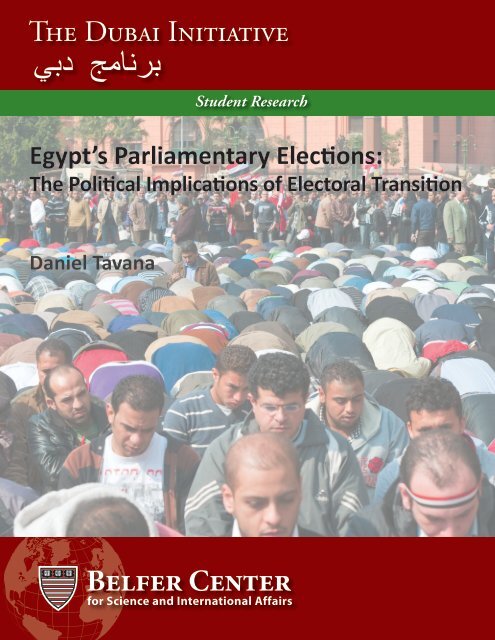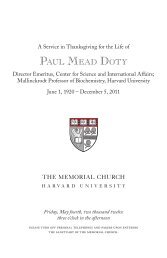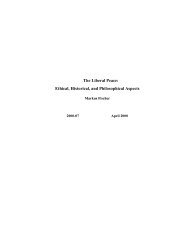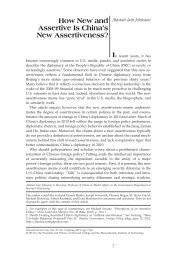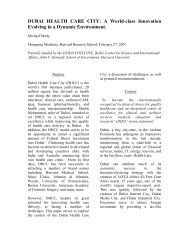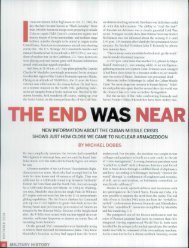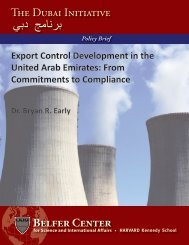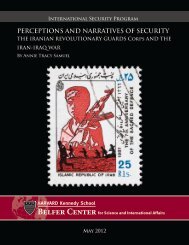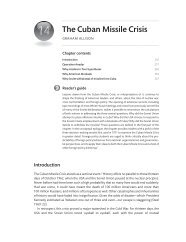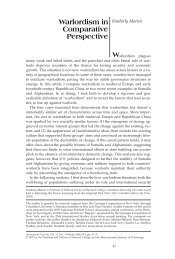Tavana--Egypt Elections Guide - Belfer Center for Science and ...
Tavana--Egypt Elections Guide - Belfer Center for Science and ...
Tavana--Egypt Elections Guide - Belfer Center for Science and ...
You also want an ePaper? Increase the reach of your titles
YUMPU automatically turns print PDFs into web optimized ePapers that Google loves.
The Dubai Initiative<br />
<strong>Egypt</strong>’s Parliamentary <strong>Elections</strong>:<br />
The Political Implications of Electoral Transition<br />
Daniel <strong>Tavana</strong><br />
Student Research
<strong>Egypt</strong>’s Parliamentary <strong>Elections</strong>:<br />
The Political Implications of Electoral Transition<br />
Dubai Initiative – Student Research<br />
Daniel <strong>Tavana</strong><br />
Master’s in Public Policy C<strong>and</strong>idate<br />
Harvard Kennedy School of Government<br />
December 2011
InTroducTIon<br />
<strong>Egypt</strong>’S paRlIamEntaRy ElEctIonS | 3<br />
this policy brief analyzes <strong>Egypt</strong>’s electoral framework in light of legal <strong>and</strong> political<br />
changes following the popular revolt that overthrew <strong>Egypt</strong>ian president Hosni mubarak<br />
in February 2011. over the course of a three <strong>and</strong> a half month period, <strong>Egypt</strong>ians will elect<br />
representatives to lower <strong>and</strong> upper houses of parliament: the people’s assembly <strong>and</strong> the<br />
Shura council, respectively. once both houses convene in march 2012, a 100-member<br />
constituent assembly will be selected to draft a new constitution.<br />
ThE ElEcToral SySTEm bE<strong>for</strong>E mubarak<br />
<strong>Egypt</strong>’s current constitution was first enacted in 1971 under the leadership of<br />
president anwar Sadat. the document facilitated Sadat’s comm<strong>and</strong> of institutional rivals<br />
<strong>and</strong> reconfigured the state’s ideology. according to Brown (2011):<br />
the result was a document that promised a little bit to everybody – but everything<br />
to the president. the constitution contained guarantees <strong>for</strong> individual<br />
freedoms, democratic procedures, <strong>and</strong> judicial independence. It made nods<br />
toward socialism <strong>and</strong> Islam. But <strong>for</strong> every commitment, there was also a trap<br />
door; <strong>for</strong> every liberty, there was a loophole that ultimately did little to rein in<br />
the power of the president or the country’s determined security apparatus. 1<br />
Upon its enactment, the constitution did not dramatically change the structure<br />
of parliament, known as the people’s assembly (pa). Under the new constitution, the assembly<br />
was charged with exercising legislative power, approving the general policies of<br />
the state, putting <strong>for</strong>th social <strong>and</strong> economic policies, <strong>and</strong> managing the budget. the law<br />
further stipulated that the pa should consist of at least 350 members, half of which must<br />
be workers <strong>and</strong> farmers. 2 members would be elected by direct secret public balloting;<br />
once the election was complete, the president could appoint an additional ten members<br />
to the body.<br />
In law number 38 (1972) <strong>and</strong> subsequent amendments, the rules <strong>and</strong> regulations<br />
governing elections to the pa were codified. the assembly would consist of 444 members,<br />
at least half of which must consist of workers <strong>and</strong> farmers. as stipulated in the constitution,<br />
the president would also appoint an additional ten members. the country would<br />
be divided into 222 districts, each of which was responsible <strong>for</strong> electing two members.<br />
a 2009 amendment that set a quota <strong>for</strong> female members created an additional 64 seats<br />
(across 32 districts) <strong>for</strong> women in the pa. the changes took effect in pa elections the following<br />
year.
4 | DUBaI InItIatIvE – StUDEnt RESEaRcH<br />
In law number 120 (1980), an upper house, known as the Shura council, was created<br />
to more directly bring the <strong>Egypt</strong>ian press under the state’s control. the council was<br />
given 51% ownership of the national press, <strong>and</strong> tasked with appointing the leadership of<br />
several national newspapers. the council would consist of 264 members: one-third of<br />
which would be appointed by the president. the remaining 176 would be elected just as<br />
they were in the pa: 88 districts would each elect two members.<br />
ThE rEvoluTIon <strong>and</strong> ITS afTErmaTh<br />
The popular uprising that led to the overthrow of President Mubarak led to sweeping<br />
legal changes <strong>and</strong> a new electoral framework. The changes can be observed chronologically,<br />
beginning in February 2011.<br />
The constitutional referendum<br />
two days after mubarak’s resignation, the Supreme council of the armed Forces<br />
(ScaF) filled the political vacuum caused by the president’s departure. In a statement,<br />
ScaF asserted its “historical <strong>and</strong> constitutional responsibility to protect the country” <strong>and</strong><br />
announced the following:<br />
• the constitution would be suspended immediately;<br />
• ScaF would temporarily administer the affairs of the country <strong>for</strong> a period of six<br />
months or until pa, Shura council, <strong>and</strong> presidential elections are held;<br />
• ScaF chairman mohammad Hussein tantawi would represent <strong>Egypt</strong> internally<br />
<strong>and</strong> externally (making him the de facto head of state);<br />
• the pa <strong>and</strong> Shura council would be dissolved;<br />
• ScaF would issue laws during the transitional period;<br />
• a constitutional Drafting committee would be convened, followed by a popular<br />
referendum to ratify the new constitution. 3<br />
the constitutional Drafting committee was charged with establishing a process <strong>for</strong><br />
drafting <strong>and</strong> adopting a new constitution, creating free <strong>and</strong> fair elections, <strong>and</strong> limiting the<br />
state’s violation of individual freedoms. on February 26, the committee submitted eleven<br />
amendments, which included: the imposition of term limits <strong>and</strong> checks on presidential<br />
power, judicial supervision of elections, <strong>and</strong> limitations on the executive’s ability to declare<br />
a state of emergency. 4 In a nationwide referendum held on march 19, 77% of voters<br />
approved the committee’s proposals.
ThE conSTITuTIonal dEclaraTIon<br />
<strong>Egypt</strong>’S paRlIamEntaRy ElEctIonS | 5<br />
Soon after, on march 30, ScaF introduced a “constitutional Declaration” following<br />
the public’s approval of the amendments. 5 The document would hence<strong>for</strong>th serve<br />
as <strong>Egypt</strong>’s provisional constitution. It included the approved amendments, other articles<br />
from the 1971 document, <strong>and</strong> some completely new provisions.<br />
more importantly, the declaration effectively created a legal basis <strong>for</strong> ScaF’s rule.<br />
though ScaF had asserted its constitutional obligation to stabilize the country following<br />
mubarak’s departure, it now had a legal foundation to do so under the direction of a provisional<br />
constitution. the Declaration also adjusted the timetable <strong>for</strong> elections <strong>and</strong> <strong>for</strong> the<br />
convening of a constituent assembly to draft the constitution:<br />
the members of the first people’s assembly <strong>and</strong> Shura council (except the appointed<br />
members) will meet in a joint session following an invitation from the<br />
Supreme council of the armed Forces within 6 months of their election to elect<br />
a provisional assembly composed of 100 members which will prepare a new<br />
draft constitution <strong>for</strong> the country to be completed within 6 months of the <strong>for</strong>mation<br />
of this assembly. the draft constitution will be presented within 15 days<br />
of its preparation to the people who will vote in a referendum on the matter.<br />
the constitution will take effect from the date on which the people approve<br />
the referendum.<br />
the article did not specify how the 100 members would be chosen, nor did it explicitly<br />
state when presidential elections would be held.<br />
Subsequent Scaf changes 6<br />
now that ScaF had the authority to legislate, it made several modifications to the<br />
country’s laws <strong>and</strong> electoral framework. on may 30, ScaF <strong>for</strong>mally proposed rules governing<br />
elections to parliament. Under the proposal, one-third of pa <strong>and</strong> Shura council seats<br />
would be elected by a party list, proportional (pR) voting scheme, with two-thirds elected<br />
under the previous individual c<strong>and</strong>idate system. political parties <strong>and</strong> groups opposed the<br />
proposal, claiming that it robbed political parties of power <strong>and</strong> would encourage <strong>for</strong>mer<br />
nDp officials to run as individual c<strong>and</strong>idates. 7<br />
on July 20, 2011, ScaF again changed the law, proposing an even split between<br />
party list <strong>and</strong> individual c<strong>and</strong>idate seats. SCAF further complicated the electoral <strong>for</strong>mula<br />
by creating two separate sets of districts <strong>for</strong> the two types of votes. 126 districts would<br />
elect 252 individual c<strong>and</strong>idates, <strong>and</strong> 58 districts would elect an additional 252 members
6 | DUBaI InItIatIvE – StUDEnt RESEaRcH<br />
from lists, bringing the number of members to 504. Each <strong>Egypt</strong>ian citizen became a member<br />
of four districts: one party list district <strong>and</strong> one individual c<strong>and</strong>idate district <strong>for</strong> both the<br />
PA <strong>and</strong> Shura Council. 8 political parties were open to the change, though pressure on ScaF<br />
to use an entirely list system still mounted.<br />
on September 25, ScaF changed the law once more, this time in the <strong>for</strong>m of an<br />
amendment to the constitutional Declaration. now, two-thirds of all members would be<br />
elected by party lists <strong>and</strong> only one-third elected as individual c<strong>and</strong>idates. Subsequent<br />
ScaF decrees would delineate the number of districts <strong>for</strong> each system. For the pa, the<br />
country would be divided into 46 list districts <strong>and</strong> 83 individual c<strong>and</strong>idate districts. the<br />
list districts would elect 332 pa members, while the individual c<strong>and</strong>idate districts would<br />
elect 166. For the Shura council, the country would be divided into 30 districts <strong>for</strong> both<br />
list <strong>and</strong> individual c<strong>and</strong>idates. Each district would elect four members from the list system<br />
<strong>and</strong> two members from the individual c<strong>and</strong>idate system. <strong>Elections</strong> to the pa would be held<br />
from november 28 to January 10, <strong>and</strong> elections <strong>for</strong> the Shura council would be held from<br />
January 29 to march 11.<br />
ThE ElEcToral SySTEm<br />
By october 1, ScaF had solidified <strong>Egypt</strong>’s mixed-member majoritarian electoral<br />
system. c<strong>and</strong>idates were invited to register, <strong>and</strong> lists <strong>and</strong> c<strong>and</strong>idate rolls would be released<br />
as the elections progressed. this section delves deeper into <strong>Egypt</strong>’s electoral system,<br />
with particular attention to the electoral <strong>for</strong>mula <strong>and</strong> certain political phenomena<br />
likely to influence the election’s outcome.<br />
Election Timetable<br />
<strong>Egypt</strong>ians are electing representatives over the course of a three-<strong>and</strong>-a-half month<br />
period, which began on november 28. the pa elections will run from november 28 to<br />
January 10, with Shura council elections running from January 29 to march 11. For each<br />
body, voting will take place over six different time periods, including optional runoff elections.<br />
Figure 1 provides a timeline of each election period, in chronological order.
Figure 1. <strong>Elections</strong> timeline<br />
<strong>Egypt</strong>’S paRlIamEntaRy ElEctIonS | 7<br />
Each of <strong>Egypt</strong>’s 27 governorates is assigned a particular phase, or time period, in<br />
which it will vote. phase 1 includes cairo, port Said, Damietta, Kafr el-Sheikh, alex<strong>and</strong>ria,<br />
Fayoum, asyut, luxor <strong>and</strong> Red Sea; phase 2 includes giza, Bani Suef, Sohag, aswan, Suez,<br />
Ismailiya, Sharqiya, monufiya, <strong>and</strong> Beheira; <strong>and</strong> phase 3 includes north Sinai, South Sinai,<br />
Daqahliya, gharbiya, Qalyubia, matruh, minya, new valley, <strong>and</strong> Qena. Figure 2 provides a<br />
visualization of the governorates <strong>and</strong> the phases they have been assigned.
8 | DUBaI InItIatIvE – StUDEnt RESEaRcH<br />
Figure 2. Governorates <strong>and</strong> voting phases<br />
dISTrIcTInG<br />
to add to the electoral system’s complexity, different sets of districts correspond to<br />
different voting systems <strong>and</strong> different houses of parliament. For pa elections, the country<br />
is divided into two sets of districts: one <strong>for</strong> the party list (pR) system, <strong>and</strong> one <strong>for</strong> the individual<br />
c<strong>and</strong>idate (Ic) system. the country’s 27 governorates are divided into 46 party list<br />
districts, which will elect 332 members, or two-thirds of parliament (<strong>for</strong> an average district<br />
magnitude of 7.2). For the individual c<strong>and</strong>idate system, these districts are further divided<br />
to <strong>for</strong>m 83 districts, which will elect 166 members, or one-third of parliament. When each<br />
<strong>Egypt</strong>ian voter goes to the polls, he or she will select two individual c<strong>and</strong>idates <strong>and</strong> one<br />
party list.
<strong>Egypt</strong>’S paRlIamEntaRy ElEctIonS | 9<br />
Figure 3 below illustrates the breakdown of PA districts <strong>for</strong> each system. A more<br />
expansive list including the magnitude of each party list multi-member district can be<br />
found in Appendix A.<br />
Figure 3. Pa districts <strong>for</strong> Pr <strong>and</strong> Ic seats 9<br />
Governorate<br />
Population<br />
(thous<strong>and</strong>s)<br />
Population<br />
(%)<br />
Pr districts<br />
(#)<br />
Pr<br />
seats<br />
(#)<br />
Ic districts<br />
(#)<br />
Ic seats<br />
(#)<br />
Total<br />
seats<br />
Total<br />
seats<br />
(%)<br />
alex<strong>and</strong>ria 4,438 5.6% 2 16 4 8 24 4.8%<br />
aswan 1,292 1.6% 1 4 1 2 6 1.2%<br />
asyut 3,800 4.8% 2 16 4 8 24 4.8%<br />
bani Suef 2,540 3.2% 2 12 3 6 18 3.6%<br />
beheira 5,206 6.5% 2 20 5 10 30 6.0%<br />
cairo 9,168 11.5% 4 36 9 18 54 10.8%<br />
damietta 1,211 1.5% 1 8 2 4 12 2.4%<br />
daqahliya 5,440 6.8% 3 24 6 12 36 7.2%<br />
fayoum 2,803 3.5% 2 12 3 6 18 3.6%<br />
Gharbiya 4,347 5.5% 2 20 5 10 30 6.0%<br />
Giza 6,210 7.8% 2 20 5 10 30 6.0%<br />
Ismailiya 1,057 1.3% 1 4 1 2 6 1.2%<br />
kafr el-Sheikh 2,875 3.6% 2 12 3 6 18 3.6%<br />
luxor 1,043 1.3% 1 4 1 2 6 1.2%<br />
matruh 372 0.5% 1 4 1 2 6 1.2%<br />
minya 4,607 5.8% 2 16 4 8 24 4.8%<br />
monufiya 3,580 4.5% 2 16 4 8 24 4.8%<br />
new valley 204 0.3% 1 4 1 2 6 1.2%<br />
north Sinai 385 0.5% 1 4 1 2 6 1.2%<br />
Port Said 617 0.8% 1 4 1 2 6 1.2%<br />
Qalyubia 4,636 5.8% 2 12 3 6 18 3.6%<br />
Qena 2,738 3.4% 2 12 3 6 18 3.6%<br />
red Sea 313 0.4% 1 4 1 2 6 1.2%<br />
Sharqiya 5,876 7.4% 2 20 5 10 30 6.0%<br />
Sohag 4,124 5.2% 2 20 5 10 30 6.0%<br />
South Sinai 157 0.2% 1 4 1 2 6 1.2%<br />
Suez 563 0.7% 1 4 1 2 6 1.2%<br />
Totals 79,602 46 332 83 166 498
10 | DUBaI InItIatIvE – StUDEnt RESEaRcH<br />
District lines <strong>for</strong> the Shura council are far less complicated, as the country is divided into<br />
30 districts <strong>for</strong> both the party list <strong>and</strong> individual c<strong>and</strong>idate systems. Each of the country’s<br />
27 governorates will elect two individual c<strong>and</strong>idates, <strong>and</strong> four members through party<br />
lists. cairo, giza, <strong>and</strong> Dahaklia, however, are each divided in half, thus doubling the number<br />
of members they elect. as such, 120 members will be elected through lists, <strong>and</strong> 60<br />
members will be elected as individual c<strong>and</strong>idates. For a more expansive list of seat allocation<br />
in Shura council districts, see appendix B.<br />
vote distribution<br />
once the ballots are counted, seats will be apportioned according to two different<br />
systems <strong>for</strong> both the party list <strong>and</strong> individual c<strong>and</strong>idate <strong>for</strong>mulas.<br />
For the party list system, <strong>Egypt</strong> has adopted the largest remainder method to apportion<br />
seats. according to article 15 of the amended law number 38 (1972):<br />
Representatives of each constituency of the closed lists shall be elected by giving<br />
each list a number of the constituency seats by the number of valid votes<br />
the list obtained to the total number of valid votes of voters that the parties’<br />
lists had obtained in the constituency, adhering to the order on each list, <strong>and</strong><br />
the remaining seats shall be distributed to the lists according to the sequence<br />
of the highest remaining votes <strong>for</strong> each list.<br />
<strong>Egypt</strong> will use the Hare quota <strong>for</strong>mula to assign the remaining votes. the Hare<br />
quota is obtained by dividing the number of votes cast in a district by the number of total<br />
seats. the example below describes the use of the Hare quota as it applies to luxor’s<br />
only pa party list district. assuming all of luxor’s eligible voters (approximately 675,000<br />
people) participate in the elections, we could envision the following scenario, using hypothetical<br />
vote counts:
Party Total votes Total votes (%) Total quotas (#)<br />
Seats assigned<br />
<strong>Egypt</strong>’S paRlIamEntaRy ElEctIonS | 11<br />
remainder<br />
additional<br />
seats<br />
Party a 234,097 34.7% 1.388 1 0.388 0 1<br />
Party b 116,711 17.3% 0.692 0 0.692 1 1<br />
Party c 86,353 12.8% 0.512 0 0.512 1 1<br />
Party D 75,559 11.2% 0.448 0 0.448 1 1<br />
Party E 39,803 5.9% 0.236 0 0.236 0 0<br />
Party f 34,406 5.1% 0.204 0 0.204 0 0<br />
Party G 26,985 4.0% 0.16 0 0.16 0 0<br />
Party H 26,311 3.9% 0.156 0 0.156 0 0<br />
Party I 14,842 2.2% 0.088 0 0.088 0 0<br />
Party J 10,119 1.5% 0.06 0 0.06 0 0<br />
Party k 5,397 0.8% 0.032 0 0.032 0 0<br />
Party L 4,048 0.6% 0.024 0 0.024 0 0<br />
Totals 674,631 100.0% 4 1 3 3 4<br />
Total<br />
seats<br />
the Hare quota in this district is 168,657 (one-quarter the total number of votes,<br />
since there are four seats available). according to the hypothetical above, party a receives<br />
nearly 35% of the popular vote, despite only winning one seat. the three parties with the<br />
next highest remainders, parties B, c, <strong>and</strong> D, each receive one seat though none of them<br />
earned a quota. It should also be noted that there is a very low national threshold of 0.5%.<br />
If a party or party coalition fails to gain 0.5% of the national popular vote, it cannot be<br />
represented in Parliament.<br />
In order to ensure that half of each pR district consists of workers <strong>and</strong> farmers, the<br />
following <strong>for</strong>mula will be used in the event of an imbalance: coefficient = total number of<br />
valid list voters divided by number of seats won by the list. The list with the smallest coefficient<br />
must elevate a worker or farmer to the top of its list. 10<br />
For the individual c<strong>and</strong>idate system, there are few changes to the mechanisms by<br />
which individuals are elected, though they are still complex. at the polls, voters cast their<br />
votes <strong>for</strong> two individuals who may or may not be affiliated with a party. they can vote either<br />
<strong>for</strong> one professional <strong>and</strong> one worker/farmer, two professionals, or two worker/farmers.<br />
the two c<strong>and</strong>idates who receive an absolute majority are declared winners, provided<br />
at least one of them is a worker or farmer. If only one professional receives a majority, he<br />
or she is declared elected, <strong>and</strong> a runoff is held a week later between the top two worker/<br />
farmers. If only one worker/farmer receives an absolute majority, a runoff is also held<br />
between the next two c<strong>and</strong>idates. If two professionals secure absolute majorities, the
12 | DUBaI InItIatIvE – StUDEnt RESEaRcH<br />
one with the higher vote count wins <strong>and</strong> a runoff is held between the highest-ranking<br />
worker/farmers.<br />
If no c<strong>and</strong>idate secures an absolute majority, a runoff will be held between the<br />
four highest vote getters—half of whom must belong to the worker/farmer category. the<br />
two highest vote getters win seats, again provided at least one is a worker or farmer.<br />
ParTIES <strong>and</strong> ElEcToral blocS<br />
after mubarak’s resignation in February, dozens of political parties rushed to register,<br />
recruit <strong>and</strong> train c<strong>and</strong>idates, <strong>and</strong> mobilize voters. this section highlights some of the<br />
more notable parties, coalitions, <strong>and</strong> other political groups likely to influence the composition<br />
of parliament.<br />
The freedom <strong>and</strong> Justice Party <strong>and</strong> the democratic alliance<br />
With the dissolution of the nDp, the muslim Brotherhood <strong>and</strong> its associated political<br />
party, the Freedom <strong>and</strong> Justice party (FJp), has emerged as the most organized political<br />
<strong>for</strong>ce contesting seats in parliament. the Brotherhood announced its intention to <strong>for</strong>m an<br />
independent party days after mubarak’s resignation. though it is largely shaped by the<br />
Brotherhood’s religious frame of reference, the party’s leadership is distinct from that of the<br />
Brotherhood. By <strong>and</strong> large, however, the party has espoused the Brotherhood’s ideology.<br />
not surprisingly, some analysts have categorized the FJp as an “Islamist” party aiming<br />
to subvert the secular character of the <strong>Egypt</strong>ian state. generally, the Brotherhood<br />
believes that “freedom must be bounded by respect <strong>for</strong> God’s law. Most members emphasize<br />
judicial independence, but they also believe in ‘erecting a value system in society<br />
that is derived from Islamic law, <strong>and</strong> that is hegemonic over the judicial system <strong>and</strong> the<br />
legislative <strong>and</strong> executive branches.’” 11 Some members of the muslim Brotherhood may<br />
not advocate on behalf of core democratic values, but they undoubtedly see themselves<br />
as the prime beneficiaries of democratic procedures.<br />
Despite the Brotherhood’s history <strong>and</strong> reputation as a religious party, the FJp has<br />
committed to a democratic, civil state <strong>and</strong> to free market capitalism in its plat<strong>for</strong>m <strong>and</strong><br />
official declaration. the party leads the Democratic alliance, a coalition of several small<br />
parties who are running as a single list. 12 the coalition was initially <strong>for</strong>med in June, when<br />
nearly 30 parties <strong>and</strong> c<strong>and</strong>idates aimed to <strong>for</strong>m a broad coalition including primarily religious<br />
<strong>and</strong> nationalist parties. that coalition eventually dissolved amidst claims that the<br />
FJp would not compromise over the placement of FJp c<strong>and</strong>idates on party lists, though.
The <strong>Egypt</strong>ian bloc <strong>and</strong> new liberal Parties<br />
<strong>Egypt</strong>’S paRlIamEntaRy ElEctIonS | 13<br />
the <strong>Egypt</strong>ian Bloc consists of the Free <strong>Egypt</strong>ians party (FEp), the Social Democratic<br />
party (SDp), <strong>and</strong> tagammu, a socialist-leaning unionist party <strong>for</strong>med in 1976. the FEp <strong>and</strong><br />
the SDp dominate the Bloc’s lists, accounting <strong>for</strong> roughly 90% of its c<strong>and</strong>idates. Both parties<br />
emerged in the aftermath of the revolution in light of perceived threats to the civil,<br />
secular character of the state. the FEp was created by telecom tycoon naguib Sawiris <strong>and</strong><br />
other liberal elites dissatisfied with the ability of other liberal parties to credibly compete<br />
against the FJp. Similarly, the SDp brought university professors <strong>and</strong> other left-leaning liberals<br />
together to bridge the divide between liberal elites <strong>and</strong> grassroots leftist activists.<br />
It should be noted, however, that the Bloc’s members have different ideologies.<br />
the FEp is market-oriented <strong>and</strong> pro-business, while tagammu has historically advocated<br />
against privatization. although the coalition opened its doors to religious groups early on,<br />
most <strong>Egypt</strong>ians believe the Bloc is organized primarily around its opposition to the FJp.<br />
the Bloc will submit lists <strong>for</strong> each pR district, <strong>and</strong> about half of all individual c<strong>and</strong>idate<br />
districts.<br />
The revolution continues alliance (rca) <strong>and</strong> other leftist Groups<br />
Following the 2010 parliamentary elections, several high-ranking members of tagammu<br />
quit the party, alleging its closeness to the regime <strong>and</strong> its complicity in fixing the<br />
elections. many of those leaders <strong>for</strong>med the popular Socialist alliance party, the dominant<br />
<strong>for</strong>ce behind the movement <strong>and</strong> the only recognized party permitted to <strong>for</strong>m lists from<br />
among the coalition members. the alliance includes leftists, younger students involved in<br />
the revolution, <strong>and</strong> religious offshoots of the FJp. It was <strong>for</strong>med hastily be<strong>for</strong>e c<strong>and</strong>idate<br />
registration deadlines, <strong>and</strong> though many Rca members <strong>and</strong> affiliates are well known in<br />
opposition circles, their critics cite their disorganization <strong>and</strong> inexperience as likely to hurt<br />
their election prospects.<br />
other alliance members include the <strong>Egypt</strong>ian current party, amr Hamzawy’s<br />
Freedom <strong>Egypt</strong> party, members of the Revolutionary youth coalition, <strong>and</strong> the <strong>Egypt</strong>ian<br />
Socialist Party.<br />
Salafi Parties <strong>and</strong> the “alliance <strong>for</strong> <strong>Egypt</strong>”<br />
more commonly referred to as the “Islamist alliance,” the alliance <strong>for</strong> <strong>Egypt</strong> consists<br />
of three Salafi parties who ab<strong>and</strong>oned the Democratic alliance days be<strong>for</strong>e c<strong>and</strong>idates<br />
were required to register. the alliance is led by the al nour (light) party, an alex<strong>and</strong>ria-based<br />
party with origins in the Salafi group al Daawa al Salafiya, (“the Salafist call”).
14 | DUBaI InItIatIvE – StUDEnt RESEaRcH<br />
al Wafd<br />
the coalition also includes the al asala <strong>and</strong> Building <strong>and</strong> Development parties, <strong>and</strong> is<br />
slated to per<strong>for</strong>m particularly well in coastal districts, <strong>and</strong> others in Upper <strong>Egypt</strong>.<br />
many analysts have given considerable attention to Salafi movements, given their<br />
previous associations with militants <strong>and</strong> their positions with regard to the role of women.<br />
generally, however, Salafi parties accept the democratic process <strong>and</strong> remain confident<br />
in their broad appeal. the coalition will field female c<strong>and</strong>idates, even amidst accusations<br />
from rivals that Salafis will attempt to limit women’s rights once elected.<br />
<strong>Egypt</strong>’s oldest liberal party, the Wafd, is expected to win a number of seats despite<br />
their limited popularity. the party was heavily criticized be<strong>for</strong>e <strong>and</strong> during the revolution<br />
<strong>for</strong> their closeness to the regime <strong>and</strong> their willingness to side against activists <strong>and</strong> protestors<br />
when convenient. the Wafd’s popularity further declined after the party announced<br />
its intent to <strong>for</strong>m lists with the FJp in the summer, although this never materialized.<br />
the Wafd has always advocated <strong>for</strong> a liberal democratic conception of political life,<br />
guaranteed by open markets, limited public sector provisions, <strong>and</strong> robust political liberties.<br />
In recent history, the Wafd has advocated specifically <strong>for</strong> an end to emergency rule,<br />
multi-party governance, <strong>and</strong> re<strong>for</strong>m of undemocratic institutions. Even despite declining<br />
influence <strong>and</strong> appeal, the party is well organized <strong>and</strong> will likely compete in most districts.<br />
al Wasat (center) Party<br />
al Wasat was the first post-revolutionary party to obtain legal recognition, though<br />
it applied <strong>for</strong> a license in 1996. the party was founded in the 1990s, primarily in opposition<br />
to the muslim Brotherhood. Indeed, key features of the party’s activities involve<br />
opposing both the rigid organizational structure <strong>and</strong> ideological inflexibility of the Brotherhood<br />
movement, <strong>and</strong> several co-founders were <strong>for</strong>mer Brotherhood officials. al Wasat<br />
was instrumental in <strong>for</strong>ming the Kefaya (Enough) movement, one of the first movements<br />
to call <strong>for</strong> mubarak’s resignation during the Revolution.<br />
the party is generally perceived to be a moderate alternative to the FJp, though its<br />
official policies are similar. al Wasat emphasizes the balance between the civil character<br />
of the <strong>Egypt</strong>ian state <strong>and</strong> the religious conservatism of <strong>Egypt</strong>ians, though they admit their<br />
policies have an Islamic frame of reference. additionally, party leaders advocate <strong>for</strong> open<br />
markets <strong>and</strong> minimal state intervention. Both coptic christians <strong>and</strong> women will run on the<br />
party’s lists.
The national democratic Party <strong>and</strong> “remnants”<br />
<strong>Egypt</strong>’S paRlIamEntaRy ElEctIonS | 15<br />
mubarak’s ruling national Democratic party (nDp), though dissolved <strong>and</strong> banned,<br />
is still likely to affect the trajectory of the elections process. many <strong>for</strong>mer nDp officials<br />
have joined party lists, <strong>and</strong> several have come together to <strong>for</strong>m entirely new parties, such<br />
as the Freedom party, the citizen party, the conservative party, <strong>and</strong> the national party,<br />
among others. the individuals running with these parties have varying degrees of affiliation<br />
with the <strong>for</strong>mer regime. Some served as high-ranking members very close to the<br />
<strong>for</strong>mer president, while others include local leaders co-opted by the party. <strong>Egypt</strong>ians have<br />
generally responded negatively to ef<strong>for</strong>ts by <strong>for</strong>mer nDp officials to contest seats. most<br />
<strong>Egypt</strong>ians colloquially refer to them as feloul, or “remnants.” one website, Emsek Feloul<br />
(literally “catch the Remnants” in arabic), aims to publically identify nDp partisans participating<br />
in the elections.<br />
PolIcy ImPlIcaTIonS<br />
a fractured Parliament?<br />
the electoral system favors small parties at the expense of legislative effectiveness.<br />
the system’s use of the Hare quota will likely lead to a less proportionally representative<br />
parliament, perhaps catapulting parties to seats despite their unpopularity. In the<br />
example above, party D captures one out of four seats in a list district—despite receiving<br />
only 11.2% of the overall vote. as a result, the system generally advantages party underper<strong>for</strong>mance:<br />
small- to mid-sized parties might per<strong>for</strong>m better than their national appeal<br />
would suggest. Combined with the presence of individual list winners who might not be<br />
affiliated with a party, <strong>and</strong> the sheer number of parties contesting seats, the emergence<br />
of a multi-party coalition seems unlikely.<br />
this might not be the case if established parties, such as the FJp, per<strong>for</strong>m exceptionally<br />
well. If the FJp is able to <strong>for</strong>m a majority coalition, the prospects <strong>for</strong> the emergence<br />
of a legitimate “opposition” bloc seem limited, <strong>for</strong> the reasons mentioned above.<br />
opposition parties will have little legitimacy to begin with, since they could enter parliament<br />
without ever having attained a district quota.<br />
<strong>Egypt</strong>’s low electoral threshold will also adversely impact parliamentary efficacy.<br />
In Israel, <strong>for</strong> example, a 2% threshold is required <strong>for</strong> parties to be seated in parliament. as<br />
a result, small parties abound, <strong>and</strong> parliamentary coalitions are occasionally held hostage<br />
to the dem<strong>and</strong>s of peripheral parties. <strong>Egypt</strong>’s electoral threshold is even lower. at 0.5%,<br />
<strong>Egypt</strong>’s threshold is one of the lowest in the world. The amended rules governing party
16 | DUBaI InItIatIvE – StUDEnt RESEaRcH<br />
registration have generally discouraged the <strong>for</strong>mation of local parties capable of securing<br />
list seats without national appeal, but the low threshold seems intentionally designed<br />
to permit it.<br />
The constituent assembly<br />
the primary m<strong>and</strong>ate of the newly elected parliament will be the drafting of a<br />
new constitution. this process will begin once both houses are elected, though there are<br />
considerable ambiguities in the process. originally, ScaF announced that not only would<br />
it select the assembly’s members, it would also need to approve any draft document. only<br />
then would the constitution be subject to approval by referendum. the assembly had six<br />
months to develop a document, after which presidential elections would be held.<br />
over the past few months, however, political parties have become concerned with<br />
the military’s agenda <strong>and</strong> perceived ef<strong>for</strong>ts to manipulate the constitutional process to<br />
its advantage. parties succeeded in <strong>for</strong>cing the military to relinquish its claim to select assembly<br />
members, but tensions again erupted a few weeks prior to the elections with the<br />
caretaker cabinet’s introduction of a document consisting of “supraconstitutional” principles.<br />
the move was widely criticized by political parties who believed that the military<br />
was interfering in the elections process, <strong>and</strong> protests erupted in defiance of ScaF’s ef<strong>for</strong>ts<br />
to subvert the constitutional process just be<strong>for</strong>e the elections. the debate over the selection<br />
<strong>and</strong> composition of the constituent assembly has again emerged in light of FJp <strong>and</strong> al<br />
nour’s success in the first phase of pa elections.<br />
moving <strong>for</strong>ward, parties <strong>and</strong> political groups are thinking about how to structure<br />
the new constitution. political <strong>for</strong>ces will have to agree on the rights of citizens <strong>and</strong> minorities,<br />
the role of Islam in public life, <strong>and</strong> the extent to which parliament is involved in<br />
<strong>for</strong>eign <strong>and</strong> security policy decisions. political groups will also need to manage the balance<br />
between presidential <strong>and</strong> parliamentary powers. Some political groups have favored the<br />
creation of a pure parliamentary system, but ScaF’s recent decision to hold presidential<br />
elections no later than June have made such a proposition increasingly unrealistic.<br />
Populist Pressures on <strong>Egypt</strong>ian <strong>for</strong>eign Policy<br />
In the short run, ScaF will continue to capitalize on popular frustration with<br />
mubarak-era <strong>for</strong>eign policy priorities. Since mubarak’s resignation, ScaF has signaled a<br />
symbolic willingness to align <strong>Egypt</strong>ian <strong>for</strong>eign policy with popular opinion. this is particularly<br />
apparent in two domains: relations with Israel, <strong>and</strong> development assistance from the<br />
international community.
<strong>Egypt</strong>’S paRlIamEntaRy ElEctIonS | 17<br />
In early September, protesters broke into the Israeli embassy following an incident<br />
in Sinai that left five <strong>Egypt</strong>ian police officers dead after an attack by militants in Eilat. the<br />
incident, exacerbated by the deterioration of the security situation in Sinai, was believed<br />
by some to have been encouraged by ScaF in order to distract <strong>Egypt</strong>ians from the military’s<br />
response to the police officers’ deaths. ScaF’s h<strong>and</strong>ling of the incident, its response<br />
to the embassy attack, <strong>and</strong> its imposition of the emergency law brought it under heavy<br />
criticism from most political groups.<br />
most political parties, however, have not advocated <strong>for</strong> sweeping changes to relations<br />
with Israel or the camp David accords. Some groups have advocated <strong>for</strong> a reopening<br />
of dialogue between <strong>Egypt</strong> <strong>and</strong> Israel, but there is little reason to believe that any new<br />
government will move to abrogate the agreement. Most groups do not oppose peace with<br />
Israel, though parties have emphasized the importance of public scrutiny (<strong>and</strong> parliamentary<br />
approval) in the development of future agreements <strong>and</strong> treaty obligations.<br />
With respect to development assistance, ScaF has also attempted to play on popular<br />
contempt <strong>for</strong> <strong>for</strong>eign influence <strong>and</strong> financial conditionalities. although ScaF has generally<br />
refrained from economic restructuring <strong>and</strong> re<strong>for</strong>m, it has also turned down loans<br />
from financial institutions, turning instead to loans from gulf states. throughout the summer,<br />
ScaF declined to accept an ImF loan, citing distrust <strong>and</strong> the ImF’s supposed support<br />
<strong>for</strong> Mubarak’s economic policies. Successive governments have gone back <strong>and</strong> <strong>for</strong>th over<br />
the need to accept the loan, but ScaF has maintained its position, despite a grim growth<br />
outlook, collapsing <strong>for</strong>eign reserves, <strong>and</strong> a decline in direct <strong>for</strong>eign investment.<br />
concluSIon<br />
<strong>Egypt</strong>’s transition to democracy has been challenging. the electoral system seems<br />
almost purposely designed to confuse, divide, <strong>and</strong> polarize voters over the course of a<br />
three <strong>and</strong> a half month period. the sheer length of the elections timeline could adversely<br />
affect the constitutional process, further delaying the transition <strong>and</strong> enabling continued<br />
military rule. For its part, the military has recently shown some willingness to <strong>for</strong>m a national<br />
salvation government <strong>and</strong> transfer power to a civilian authority. Its detention of<br />
activists <strong>and</strong> continued attempts to influence the constitutional process, however, will<br />
likely continue to frustrate <strong>Egypt</strong>ians, many of whom are beginning to lose faith in the<br />
transition itself.
18 | DUBaI InItIatIvE – StUDEnt RESEaRcH<br />
aPPEndIx a: numbEr of SEaTS In Each PEoPlE’S aSSEmbly Pr dISTrIcT<br />
Governorate<br />
Pr seats<br />
(#)<br />
alex<strong>and</strong>ria 16 6 10<br />
aswan 4 4<br />
asyut 16 8 8<br />
bani Suef 12 8 4<br />
beheira 20 12 8<br />
Pr district magnitudes (list sizes)<br />
1 2 3 4<br />
cairo 36 10 8 8 10<br />
damietta 8 8<br />
daqahliya 24 8 8 8<br />
fayoum 12 8 4<br />
Gharbiya 20 10 10<br />
Giza 20 10 10<br />
Ismailiya 4 4<br />
kafr el-Sheikh 12 8 4<br />
luxor 4 4<br />
matruh 4 4<br />
minya 16 8 8<br />
monufiya 16 8 8<br />
new valley 4 4<br />
north Sinai 4 4<br />
Port Said 4 4<br />
Qalyubia 12 4 8<br />
Qena 12 4 8<br />
red Sea 4 4<br />
Sharqiya 20 10 10<br />
Sohag 20 12 8<br />
South Sinai 4 4<br />
Suez 4 4<br />
Totals 332
aPPEndIx b: Shura councIl dISTrIcTS <strong>for</strong> Pr <strong>and</strong> Ic SEaTS<br />
Governorate<br />
Population<br />
(thous<strong>and</strong>s)<br />
Population<br />
(%)<br />
Pr districts<br />
(#)<br />
Pr seats<br />
(#)<br />
Ic districts<br />
(#)<br />
<strong>Egypt</strong>’S paRlIamEntaRy ElEctIonS | 19<br />
Ic seats<br />
(#)<br />
Total<br />
seats<br />
Total<br />
seats (%)<br />
alex<strong>and</strong>ria 4,438 5.6% 1 4 1 2 6 3.3%<br />
aswan 1,292 1.6% 1 4 1 2 6 3.3%<br />
asyut 3,800 4.8% 1 4 1 2 6 3.3%<br />
bani Suef 2,540 3.2% 1 4 1 2 6 3.3%<br />
beheira 5,206 6.5% 1 4 1 2 6 3.3%<br />
cairo 9,168 11.5% 2 8 2 4 12 6.7%<br />
damietta 1,211 1.5% 1 4 1 2 6 3.3%<br />
daqahliya 5,440 6.8% 2 8 2 4 12 6.7%<br />
fayoum 2,803 3.5% 1 4 1 2 6 3.3%<br />
Gharbiya 4,347 5.5% 1 4 1 2 6 3.3%<br />
Giza 6,210 7.8% 2 8 2 4 12 6.7%<br />
Ismailiya 1,057 1.3% 1 4 1 2 6 3.3%<br />
kafr el-Sheikh 2,875 3.6% 1 4 1 2 6 3.3%<br />
luxor 1,043 1.3% 1 4 1 2 6 3.3%<br />
matruh 372 0.5% 1 4 1 2 6 3.3%<br />
minya 4,607 5.8% 1 4 1 2 6 3.3%<br />
monufiya 3,580 4.5% 1 4 1 2 6 3.3%<br />
new valley 204 0.3% 1 4 1 2 6 3.3%<br />
north Sinai 385 0.5% 1 4 1 2 6 3.3%<br />
Port Said 617 0.8% 1 4 1 2 6 3.3%<br />
Qalyubia 4,636 5.8% 1 4 1 2 6 3.3%<br />
Qena 2,738 3.4% 1 4 1 2 6 3.3%<br />
red Sea 313 0.4% 1 4 1 2 6 3.3%<br />
Sharqiya 5,876 7.4% 1 4 1 2 6 3.3%<br />
Sohag 4,124 5.2% 1 4 1 2 6 3.3%<br />
South Sinai 157 0.2% 1 4 1 2 6 3.3%<br />
Suez 563 0.7% 1 4 1 2 6 3.3%<br />
Totals 79,602 30 120 30 60 180
20 | DUBaI InItIatIvE – StUDEnt RESEaRcH<br />
EndnoTES<br />
1 nathan J. Brown, “<strong>Egypt</strong>’s constitutional ghosts: Deciding the terms of cairo’s<br />
Democratic transition,” Foreign Affairs (15 February 2011). available online at: http://www.<br />
<strong>for</strong>eignaffairs.com/articles/67453/nathan-j-brown/egypts-constitutional-ghosts.<br />
2 the “workers <strong>and</strong> farmers” quota was established in 1964, during the height of nasser’s<br />
presidency <strong>and</strong> the broader arab nationalist movement. the law was designed to empower<br />
laborers <strong>and</strong> ensure broad representation in parliament. over time, however, it became<br />
an added layer of bureaucracy designed to filter c<strong>and</strong>idates. the state decided who was<br />
eligible <strong>for</strong> the designation through its control of the <strong>Egypt</strong>ian trade Union Federation. For<br />
a more thorough analysis of the current implications of the quota, see Jano charbel “Eye<br />
on elections: Does the workers <strong>and</strong> farmers quota help workers <strong>and</strong> farmers?” al masry<br />
al youm (27 november 2011). available online at http://www.almasryalyoum.com/en/<br />
node/520876.<br />
3 “the Supreme council of the armed Forces: constitutional proclamation,” <strong>Egypt</strong>ian State<br />
In<strong>for</strong>mation Service. available online at http://www.sis.gov.eg/En/Story.aspx?sid=53709.<br />
4 For more in<strong>for</strong>mation on the approved amendments, see nathan J. Brown <strong>and</strong> michele<br />
Dunne, “<strong>Egypt</strong>’s Draft constitutional amendments answer Some Questions <strong>and</strong> Raise<br />
others,” the carnegie Endowment <strong>for</strong> International peace (1 march 2011). available<br />
online at: http://carnegieendowment.org/2011/03/01/egypt-s-draft-constitutional-<br />
amendments-answer-some-questions-<strong>and</strong>-raise-others/fr.<br />
5 “constitutional Declaration 2011,” <strong>Egypt</strong>ian government Services portal. available online<br />
at http://www.egypt.gov.eg/english/laws/constitution/default.aspx.<br />
6 the following sections rely on legal amendments <strong>and</strong> ScaF decrees, specifically: law<br />
number 38 (1972), law number 120 (1980), ScaF Decrees 120, 121, 122, 123, 199, <strong>and</strong><br />
200. For more in<strong>for</strong>mation <strong>and</strong> full text translations, see “<strong>Elections</strong> in <strong>Egypt</strong>: analysis of<br />
the 2011 parliamentary Electoral System,” International Foundation <strong>for</strong> Electoral Systems<br />
(november 2011). available online at: http://www.ifes.org/~/media/Files/publications/White%20paperReport/2011/analysis_of_<strong>Egypt</strong>s_2011_parliamentary_Electoral_<br />
System.pdf.<br />
7 Daniel l. tavana, “party proliferation <strong>and</strong> electoral transition in post-mubarak <strong>Egypt</strong>,”<br />
Journal of north african Studies 16.4 (2011): <strong>for</strong>thcoming.<br />
8 Ibid.<br />
9 population estimates taken from “population Estimates by Sex <strong>and</strong> governorate 1/1/2011,”<br />
<strong>Egypt</strong>ian State In<strong>for</strong>mation Service. available online at: http://www.sis.gov.eg/vR/<br />
egyptinfigures/tables/1-%20السكان/4.pdf.<br />
10 “<strong>Elections</strong> in <strong>Egypt</strong>: analysis of the 2011 parliamentary Electoral System,” International<br />
Foundation <strong>for</strong> Electoral Systems (november 2011). available online at: http://www.ifes.<br />
org/~/media/Files/publications/White%20paperReport/2011/analysis_of_<strong>Egypt</strong>s_2011_<br />
parliamentary_Electoral_System.pdf.<br />
11 tarek masoud, “liberty, democracy, <strong>and</strong> discord in <strong>Egypt</strong>,” the Washington Quarterly 34.3<br />
(2011): 125.<br />
12 the coalition also includes the Karama (Dignity) party, tomorrow (ghad) party, labor party,<br />
Re<strong>for</strong>m <strong>and</strong> Renaissance party, <strong>and</strong> the Democratic generation (geel) party, among others.
t H E D U B a I I n I t I a t I v E<br />
the Dubai Initiative is a joint venture between the Dubai School of government (DSg) <strong>and</strong> the Harvard<br />
Kennedy School (HKS), supporting the establishment of DSg as an academic, research, <strong>and</strong><br />
outreach institution in public policy, administration, <strong>and</strong> management <strong>for</strong> the middle East. the<br />
primary objective of the Initiative is to bridge the expertise <strong>and</strong> resources of HKS with DSg <strong>and</strong> enable<br />
the exchange of students, scholars, knowledge <strong>and</strong> resources between the two institutions in<br />
the areas of governance, political science, economics, energy, security, gender, <strong>and</strong> <strong>for</strong>eign relations<br />
related to the Middle East.<br />
the Initiative implements programs that respond to the evolving needs of DSg <strong>and</strong> are aligned with<br />
the research interests of the various departments <strong>and</strong> centers of HKS as well as other schools <strong>and</strong><br />
departments of Harvard University. program activities include funding, coordinating <strong>and</strong> facilitating<br />
fellowships, joint fellowships with DSg, internships, faculty <strong>and</strong> graduate research grants, working<br />
papers, multi-year research initiatives, conferences, symposia, public lectures, policy workshops,<br />
faculty workshops, case studies, <strong>and</strong> customized executive education programs delivered at DSg.<br />
For more in<strong>for</strong>mation, please visit us at www.dubaiinitiative.org<br />
the Dubai School of government (DSg) is a research <strong>and</strong> teaching institution<br />
focusing on public policy in the arab world. Established in 2005 under the patronage<br />
of HH Sheikh mohammed Bin Rashid al maktoum, vice president <strong>and</strong><br />
prime minister of the United arab Emirates <strong>and</strong> Ruler of Dubai, in cooperation<br />
with the Harvard Kennedy School, DSg aims to promote good governance<br />
through enhancing the region’s capacity <strong>for</strong> effective public policy.<br />
toward this goal, the Dubai School of government also collaborates with regional<br />
<strong>and</strong> global institutions in its research <strong>and</strong> training programs. In addition, the School organizes<br />
policy <strong>for</strong>ums <strong>and</strong> international conferences to facilitate the exchange of ideas <strong>and</strong> promote critical<br />
debate on public policy in the Arab world.<br />
the School is committed to the creation of knowledge, the dissemination of best practice <strong>and</strong> the training<br />
of policy makers in the arab world. to achieve this mission, the School is developing strong capabilities<br />
to support research <strong>and</strong> teaching programs including<br />
• applied research in public policy <strong>and</strong> management;<br />
• master’s degrees in public policy <strong>and</strong> public administration;<br />
• executive education <strong>for</strong> senior officials <strong>and</strong> executives; <strong>and</strong>,<br />
• knowledge <strong>for</strong>ums <strong>for</strong> scholars <strong>and</strong> policy makers.


